
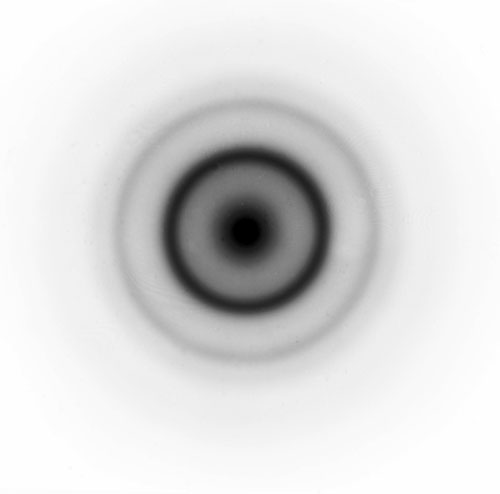
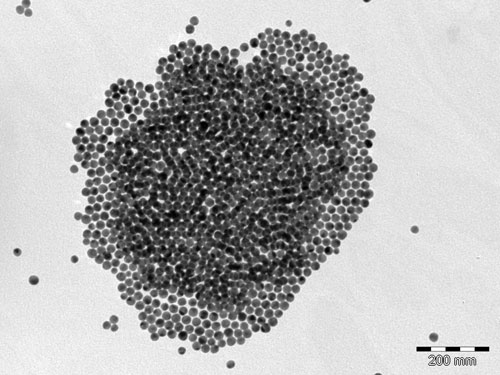
About exhibition
A direct reason for this nano exhibition became the "discovery" of old negatives from the 1990s on glass plates and completely new ones on large-format plates. I have found four kinds of pictures among a few hundred negatives of photographs taken by means of the electron microscope: surfaces of very thin crystallizing metal foils, diffractive pictures of crystallizing surfaces, magnetic domains of magnetics and nano-particles of metals in suspensions. These pictures are real, authentic, registered by means of a classic medium, and they present real nano and micro objects made "visible" thanks to electrons, they present the "primary" world at its core, invisible without the use of special instruments. However, we feel that their form is abstract.
Certain questions arise here, questions usually asked by philosophers, like does the world exist for itself or perhaps for us? Is the world such as we see it? What do we really see? And what do we understand of this world?
For the negatives, discussions and the time they took I hereby thank the physicists from the Institute of Physics of Solids at the Department of Physics and Applied Computer Science of the University of Łódź. My thanks also go to the scientists from the Centre of Molecular and Macromolecular Studies of the Polish Academy of Sciences.
Małgorzata Antoszewska-Moneta
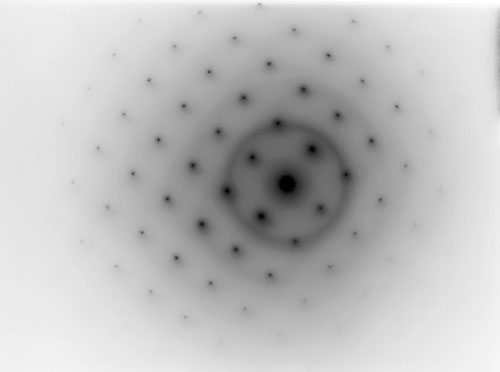
Small Is Beautiful. A Humanist’s Reflections on the Nature of the Universe
out of the knowledge of the greatest mystery
that surrounds us. These feelings grow along
with the growth of our knowledge".
Lama Gowinda
Others were composed of black circles which got a little lighter the farther they were from the centre,. These were provided with points or spots of different sizes, applied in different places on each orbit. Still others were built of densities of pointilistic spots and the rest of them could be described as convex and concave stripes of substance of unknown origin.
However, with a mysterious smile the artist told me that what I was looking at was a photograph. When I asked her whether these were photograms, she said no. So when I praised her painting and graphic manual manipulations, conducted on this printed trace of reality, or perhaps an ingenious operation conducted by means of the Photoshop programme, Moneta said that what I had before me was a purely documentary photograph of the real world. "Then what is it a photograph of?" - I asked. She did not answer, still smiling mysteriously, so I ventured that I was probably looking at celestial galaxies and black holes (which, as we all know, cannot be really "seen"), satellite pictures of mountain passes, valleys and perhaps clusters of islands surrounded by the ocean. Naturally I was wrong this time, too. Those "galaxies" and "black holes" (concentric compositions) turned out to be positive and negative diffractive pictures. In other words, that is what the diffraction of electrons on the surface of a piece of gold looks like under an electron microscope, a much more powerful instrument than the normal, optical microscope. "Islands" surrounded by the "ocean" ("densities" of spots), on the other hand, are microscopic images of nano-particles, for example of gold, while the "satellite" pictures of mountain valleys ("reliefs") are (ferro)magnetic domains.
Małgorzata Moneta decided to take us into the world hidden beyond the reality visible with the naked eye. The artist, who is also a graduate of the Department of Physics of the University of Łódź, wants us to see the microcosm. Thus thanks to her we can see molecules, atoms and even traces, i.e. the consequences, of the movement of electrons!
Therefore, these fascinating images, registered on film sensitive to the flow of the stream of electrons, are photographs not of the macro, but of the microcosm. But when fascinated and inspired by these works I started to study the structure of the Cosmos, referring to a few encyclopedias and textbooks, I decided that I was not actually very far off the truth.
Life in the Universe cannot be measured by any of our instruments, and the imagination of contemporary physicists beats the imagination of science-fiction writers by far. Scientific theories are today stranger for the common man than any metaphysical speculations or myths. The discovery of elementary particles, like quarks or leptons, dark matter, black holes which had once been stars that later underwent a gravitational collapse, or so-called multiverses which may contain many parallel universes, etc. - all those phenomena simply makes one’s head spin.
We are used to thinking according to Newton’s model which describes the world as an empty space in which solid, concrete objects can be found here and there. Everyday experience tells us that the physical world is stable, real and exists as an independent entity. But quantum mechanics claims that this is not so.
In classical physics matter is broken up into physical objects (like atoms, molecules and celestial bodies) and physical fields (like the electromagnetic or gravitational field). In quantum physics such a division disappears due to the particle/wave dualism.
This means that matter possesses the qualities of both particles and waves (called de Broglia’s waves). Light which has been traditionally considered to be a wave is also a stream of particles.
Thus quantum theory proves that the "inside" of all matter, including our bodies, is basically composed of spinning, energetic structures, closely related to and remaining in close contact with the rest of the Cosmos. The Universe is an interdependent structure of relations whose parts can be defined only in their relation to the whole.
In the 1970s David Bohm presented his idea that the Universe is built like a hologram - a hologram which is constantly moving. Matter resembles three-dimensional pictures, constructed from particles/waves in effect of electromagnetic and nuclear processes.
As we know, a hologram can be divided into smaller parts, in each of which we can see the whole three-dimensional image - but as if through a smaller "window".
The microcosm contains the same information as the macrocosm, like the atom of any given chemical element contains all its chemical qualities, or like the DNA molecules in the nuclei of cells in all living organisms contain coded information necessary for the development and functioning of the cell.
It is astonishing to see how our contemporary Western worldview, supported by whole armies of scientists, who usually conduct their research for many long years, using highly complicated instruments, resembles certain theories of reality, proposed by Eastern masters a few thousand years ago.
Ancient taoist writings suggest that there is a kind of subtle energy, emanating from the Sun, the Moon and the Earth, which permeates all of Nature. This energy is called "qi". It flows through our bodies and around them, and supports the lives of all living beings.
In a Buddhist concept - which is two thousand years old - we find a different axiom: "Emptiness is form, and form is emptiness". In Avatamsaka Sutra we can find the so-called Indra’s web, glistening with precious stones. It is a web in whose each knot a diamond shines - a diamond which reflects all the other diamonds, the whole web and itself as well. Indra’s web explains the concept of the infinite Dharmadhat in which every thing simultaneously contains all other things and laws of the Cosmos. Infinite presences of the Buddha are contained even in each particle of dust.
The concept of the current exhibition of works by Małgorzata Moneta is also quite significant, as it makes the viewer reflect on a few levels. It encourages him to engage his imagination and to enter the infinite sphere of associations. It is possible because the viewer lacks the commentary to scientific photography, he is a layman as far as natural science is concerned, and therefore he insistently tries to"decode" or recognize the object in the picture. He tries to recall images from his memory that would "fit" the images that he is watching. Moreover, he realizes how little he knows about the real image of the world and the forces that make it tick.
Every one of us is living in his own "real" world, constructed by his own brain on the basis of the information that our senses and language feed it with. We live in reality that we construct ourselves and that we need in order to live day to day. However, we lack systematic knowledge of the different levels of the Cosmos which exists objectively, independently of the cluster of our intellectual and sensory impressions.
Seeing the world in its other dimension, that is from a perspective we do not know from everyday experience, lets us discover the contents coded in it. It also makes us realize that the systems, structures and those fantastic and mysterious forms which Nature takes on, both on the macro and the micro-scale, surpasses the imagination of all artists put together. This in the end lets us understand our own position in the Cosmos.
And such is the message of this exhibition. Microscopic images of the particles of which matter is built, enlarged by Małgorzata Moneta, demonstrate that the Universe is like a giant atom, or perhaps rather a cell, which is also inhabited by us - torn between the microcosm and the macrocosm. As Erwin László says in his Systematic Image of the World, man who is neither the centre of the Universe nor the telos of evolution, seems to be the incarnation of the cosmic processes which have taken place on Earth. As human beings we have managed, although rather accidentally, to develop a certain feature which undoubtedly deserves attention: namely, we can think. And because we can think, we can count ourselves among those probably very few natural systems in the Universe that can not only sense the world and react to it, but also analyze their experiences and arrive at rational conclusions on the nature of the Universe.
Thanks to consciousness, reflection and intelligence we can, on the other hand, influence the Universe and make civilizational progress. And thanks to our imagination we can create the worlds of our dreams.
Alicja Cichowicz
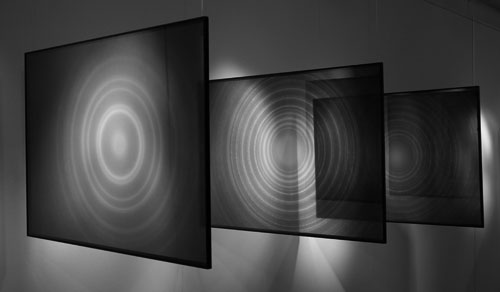
installation view
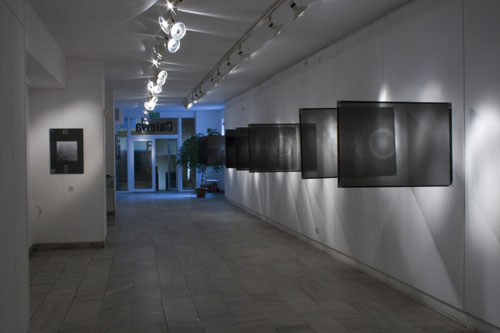
exhibition view
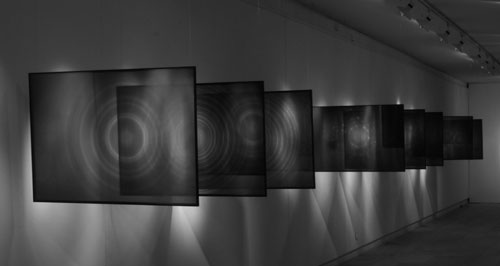
exhibition view

installation view
Copyright ©2009 Galeria FF ŁDK, Małgorzata Antoszewska-Moneta, Alicja Cichowicz